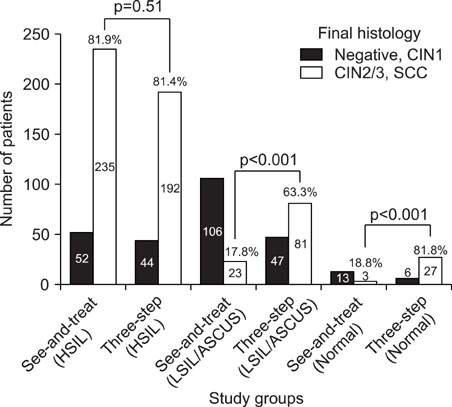J Gynecol Oncol.
2009 Sep;20(3):164-168. 10.3802/jgo.2009.20.3.164.
Treatment of the patients with abnormal cervical cytology: a "see-and-treat" versus three-step strategy
- Affiliations
-
- 1Department of Obstetrics and Gynecology, Gangnam Severance Hospital, Yonsei University College of Medicine, Seoul, Korea. jaehoonkim@yuhs.ac
- KMID: 2173449
- DOI: http://doi.org/10.3802/jgo.2009.20.3.164
Abstract
OBJECTIVE
To examine the correlation between cervical cytology and final histological results in patients who have undergone loop electrosurgical excision procedure (LEEP) with or without colposcopy-directed biopsy. METHODS: A retrospective review was performed of 829 patients who underwent LEEP for abnormal cervical cytology at Gangnam Severance Hospital between January 2004 and December 2008. Patients were classified to three groups according to cervical cytology and also divided into two groups based on the treatment they received: see-and-treat group and the standard three-step group. Final histological results were compared for the each study group. RESULTS: There were no differences in the final histological results between see-and-treat and three-step group in patients with high-grade squamous intraepithelial lesions (HSIL) cytology (N=523) (p=0.71). However, in patients with low-grade squamous intraepithelial lesions (LSIL)/atypical squamous cells of undetermined significance (ASCUS) (N=257) or normal cytology (N=49), the final histological results were significantly different between see-and-treat and three-step group (p<0.001) and the rate of overtreatment was significantly higher in the see-and-treat group (p<0.001). CONCLUSION: A see-and-treat protocol may be a viable alternative only in patients with HSIL cytology if colposcopic impression is suggestive of cervical intraepithelial neoplasia (CIN) 2 or 3 lesions.
Keyword
Figure
Reference
-
1. Pisani P, Bray F, Parkin DM. Estimates of the world-wide prevalence of cancer for 25 sites in the adult population. Int J Cancer. 2002. 97:72–81.2. Korea National Cancer Registry. Annual report of Korea national cancer registry enterprise (2002.1-2002.12). 2003. Seoul: Korea Ministry of Health and Welfare.3. Abe Y, Ito K, Okamura C, Niikura H, Terada Y, Murakami T, et al. Cervical cytologic examination during physical checkup of pregnant women: cervical cancer screening in women under the age of thirty. Tohoku J Exp Med. 2004. 204:221–228.4. Aggarwal RK, Bacus JW. A multi-spectral approach for scene analysis of cervical cytology smears. J Histochem Cytochem. 1977. 25:668–680.5. Kuo DY, Goldberg GL. Screening of cervical cancer: where do we go from here? Cancer Invest. 2003. 21:157–161.6. Cho H, Hong SW, Oh YJ, Kim MA, Kang ES, Lee JM, et al. Clinical significance of osteopontin expression in cervical cancer. J Cancer Res Clin Oncol. 2008. 134:909–917.7. Katiyar S, Thelma BK, Murthy NS, Hedau S, Jain N, Gopalkrishna V, et al. Polymorphism of the p53 codon 72 Arg/Pro and the risk of HPV type 16/18-associated cervical and oral cancer in India. Mol Cell Biochem. 2003. 252:117–124.8. Santos C, Galdos R, Alvarez M, Velarde C, Barriga O, Dyer R, et al. One-session management of cervical intraepithelial neoplasia: a solution for developing countries. A prospective, randomized trial of LEEP versus laser excisional conization. Gynecol Oncol. 1996. 61:11–15.9. Murdoch JB. The case for early intervention ('see and treat') in patients with dyskaryosis on routine cervical screening. Int J STD AIDS. 1995. 6:415–417.10. Solomon D, Davey D, Kurman R, Moriarty A, O'Connor D, Prey M, et al. The 2001 Bethesda System: terminology for reporting results of cervical cytology. JAMA. 2002. 287:2114–2119.11. Group A-LTSA. Results of a randomized trial on the management of cytology interpretations of atypical squamous cells of undetermined significance. Am J Obstet Gynecol. 2003. 188:1383–1392.12. Solomon D, Schiffman M, Tarone R. Comparison of three management strategies for patients with atypical squamous cells of undetermined significance: baseline results from a randomized trial. J Natl Cancer Inst. 2001. 93:293–299.13. Fahey MT, Irwig L, Macaskill P. Meta-analysis of Pap test accuracy. Am J Epidemiol. 1995. 141:680–689.14. Irvin WP Jr, Andersen WA, Taylor PT Jr, Stoler MH, Rice LW. "See-and-treat" loop electrosurgical excision: Has the time come for a reassessment? J Reprod Med. 2002. 47:569–574.15. Byrom J, Douce G, Jones PW, Tucker H, Millinship J, Dhar K, et al. Should punch biopsies be used when high-grade disease is suspected at initial colposcopic assessment: a prospective study. Int J Gynecol Cancer. 2006. 16:253–256.16. Sadan O, Yarden H, Schejter E, Bilevsky E, Bachar R, Lurie S. Treatment of high-grade squamous intraepithelial lesions: a "see and treat" versus a three-step approach. Eur J Obstet Gynecol Reprod Biol. 2007. 131:73–75.17. Wright TC Jr, Cox JT, Massad LS, Twiggs LB, Wilkinson EJ. 2001 Consensus Guidelines for the management of women with cervical cytological abnormalities. JAMA. 2002. 287:2120–2129.18. Holschneider CH, Ghosh K, Montz FJ. See-and-treat in the management of high-grade squamous intraepithelial lesions of the cervix: a resource utilization analysis. Obstet Gynecol. 1999. 94:377–385.19. Nobbenhuis MA, Walboomers JM, Helmerhorst TJ, Rozendaal L, Remmink AJ, Risse EK, et al. Relation of human papillomavirus status to cervical lesions and consequences for cervical-cancer screening: a prospective study. Lancet. 1999. 354:20–25.20. Hallam NF, West J, Harper C, Edwards A, Hope S, Merriman H, et al. Large loop excision of the transformation zone (LLETZ) as an alternative to both local ablative and cone biopsy treatment: a series of 1000 patients. J Gynecol Surg. 1993. 9:77–82.
- Full Text Links
- Actions
-
Cited
- CITED
-
- Close
- Share
- Similar articles
-
- Efficacy of Loop Electrosurgical Excision Procedure [LEEP] in the Diagnosis and Treatment of Abnormal Cervical Lesions
- Endocervical curettage : Does it Contribute to the Management of Patients with Abnormal Cervical Cytology?
- The Clinical Evaluation of Triple Combined Test [ Cytology, HPV DNA Test, Cervicography] for Uterine Cervical Cancer
- Diagnostic accuracy of hand-held colposcope (Gynocular) in comparison with standard colposcope in patients with abnormal cervical cytology or visual inspection with acetic acid positivity: a cross over randomized controlled study
- New insights into cervical cancer screening


